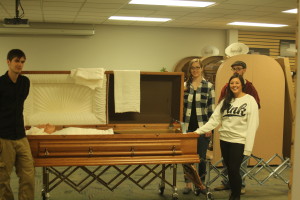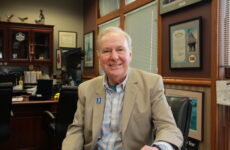 Graveyards, mad scientists, dead bodies, black cats and creepy-crawly things are what most think of in October, but many other cultures celebrate the day of the dead to honor lost loved ones.
Graveyards, mad scientists, dead bodies, black cats and creepy-crawly things are what most think of in October, but many other cultures celebrate the day of the dead to honor lost loved ones.
The men and women who work to honor the dead each day are part of the Mortuary Sciences; they have been called many things in the U.S. throughout the years such as undertaker, mortician, and funeral director.
DMACC is the only place in Iowa with a program in Mortuary Science; the nearest to DMACC are Minnesota, Kansas, and Illinois.
DMACC’s Mortuary Science program trains students to become funeral directors, but there have also been graduates that went on to work in medical examiner’s offices for cities, counties and the state.
The state requirement to become a funeral director in Iowa is 60 college credit hours and one year of mortuary science. DMACC simply requires mortuary science students to get an Associate’s degree first, since it only takes 64 credits.
Mortuary Science program director Dr. Kevin Patterson said students need to know many fields of study in order to become a funeral director.
They take science classes such as anatomy, pathology, microbiology and chemistry.
They also must know art for makeup and possible reconstruction. They must take courses in psychology to better understand grief, they even have a psychology class specific to death and grief called Thanatology.
“We need to know about grief, we need to know about religious customs and nonreligious customs, we need to know laws, we need to know all these pieces in order to really serve families well, because we don’t know exactly what each family will want until they get there,” Dr. Patterson said.
By the end, students also must learn and demonstrate their knowledge of the various materials of coffins, urns, and vaults.
Jacob Kirby was a graduate from Simpson College with a bachelor’s degree in Philosophy and psychology but he chose to come to DMACC for the mortuary science program.
“I felt it was important to bring to light the nature of grief and facilitate an open forum so that healing can begin,” Kirby said.
Others chose to go into the program for different reasons such as family.
“I want to be the fourth generation in the family business of being a funeral director. I’ll be the first female in the family in this career” said Crystal Yakel, who got her bachelor’s in human development & family studies at ISU.
Students practice speaking with each other and instructors to demonstrate what they’ve learned of psychology. One will act as the funeral director and the others will act as the grieving family.
They also work with plastic heads to learn facial construction and reconstruction.
They practice for many different ceremonies, but what many have in common is the viewing of the body.
Many, even those who have a loved one cremated, will have a viewing. Many choose this option because studies have shown it is psychologically beneficial to see the deceased in order to help the grieving process. While they all study to work with dead bodies, “There aren’t any cadavers here on campus, what we do instead is at the end of the program every student goes into a practicum where we place them in a funeral home, it’s like an internship and they work with a licensed funeral director during that time,” Patterson said.
For cremations they do in-depth cataloging and work with the medical examiner’s office to make sure all paperwork is straight, as any evidence of foul play might be burned.
Not everybody gets an autopsy; typically an autopsy will occur because of an accidental death, or an unknown cause of death.
Depending on the size of the firm, a funeral home could have 12- 15 funeral directors.
In rural towns they can have smaller numbers, maybe two or three.
The average pay for a funeral director each year ranges from $28,000 – $67,500.
Being a funeral director is not a nine to five job, somebody is always on call, and they could be called in at any time of the day or night.





Comments